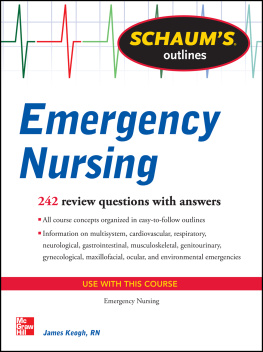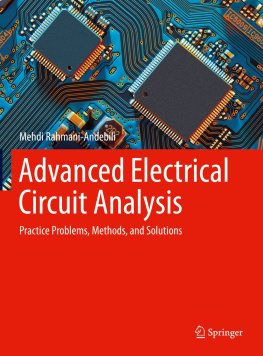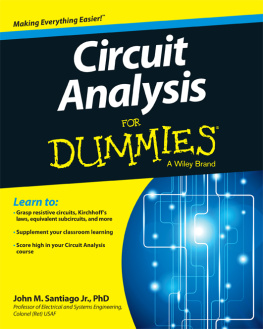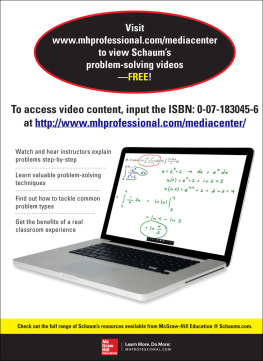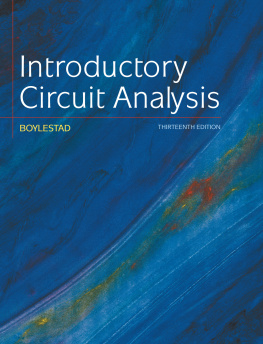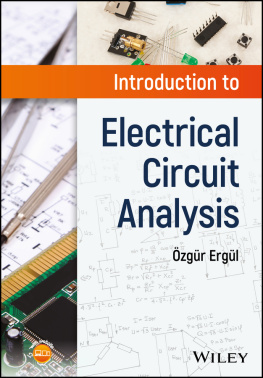JOHN R. OMALLEY is a professor of electrical engineering at the University of Florida. He received a Ph.D. degree from the University of Florida and an L.L.B. degree from Georgetown University. He is the author of two books on circuit analysis and two on the digital computer. He has been teaching courses in electric circuit analysis since 1959.

Copyright 2011 by The McGraw-Hill Companies. All rights reserved. Except as permitted under the United States Copyright Act of 1976, no part of this publication may be reproduced or distributed in any form or by any means, or stored in a database or retrieval system, without the prior written permission of the publisher.
ISBN: 978-0-07-182055-4
MHID: 0-07-182055-8
The material in this eBook also appears in the print version of this title: ISBN: 978-0-07-175643-3, MHID: 0-07-175643-4.
All trademarks are trademarks of their respective owners. Rather than put a trademark symbol after every occurrence of a trademarked name, we use names in an editorial fashion only, and to the benefit of the trademark owner, with no intention of infringement of the trademark. Where such designations appear in this book, they have been printed with initial caps.
McGraw-Hill eBooks are available at special quantity discounts to use as premiums and sales promotions, or for use in corporate training programs. To contact a representative please e-mail us at bulksales@mcgraw-hill.com.
TERMS OF USE
This is a copyrighted work and The McGraw-Hill Companies, Inc. (McGraw-Hill) and its licensors reserve all rights in and to the work. Use of this work is subject to these terms. Except as permitted under the Copyright Act of 1976 and the right to store and retrieve one copy of the work, you may not decompile, disassemble, reverse engineer, reproduce, modify, create derivative works based upon, transmit, distribute, disseminate, sell, publish or sublicense the work or any part of it without McGraw-Hills prior consent. You may use the work for your own noncommercial and personal use; any other use of the work is strictly prohibited. Your right to use the work may be terminated if you fail to comply with these terms.
THE WORK IS PROVIDED AS IS. McGRAW-HILL AND ITS LICENSORS MAKE NO GUARANTEES OR WARRANTIES AS TO THE ACCURACY, ADEQUACY OR COMPLETENESS OF OR RESULTS TO BE OBTAINED FROM USING THE WORK, INCLUDING ANY INFORMATION THAT CAN BE ACCESSED THROUGH THE WORK VIA HYPERLINK OR OTHERWISE, AND EXPRESSLY DISCLAIM ANY WARRANTY, EXPRESS OR IMPLIED, INCLUDING BUT NOT LIMITED TO IMPLIED WARRANTIES OF MERCHANTABILITY OR FITNESS FOR A PARTICULAR PURPOSE. McGraw-Hill and its licensors do not warrant or guarantee that the functions contained in the work will meet your requirements or that its operation will be uninterrupted or error free. Neither McGraw-Hill nor its licensors shall be liable to you or anyone else for any inaccuracy, error or omission, regardless of cause, in the work or for any damages resulting there from. McGraw-Hill has no responsibility for the content of any information accessed through the work. Under no circumstances shall McGraw-Hill and/or its licensors be liable for any indirect, incidental, special, punitive, consequential or similar damages that result from the use of or inability to use the work, even if any of them has been advised of the possibility of such damages. This limitation of liability shall apply to any claim or cause whatsoever whether such claim or cause arises in contract, tort or otherwise.
Dedicated to the loving memory of my brother
Norman Joseph OMalley
Lawyer, engineer, and mentor
Preface
Studying from this book will help both electrical technology and electrical engineering students learn circuit analysis with, it is hoped, less effort and more understanding. Since this book begins with the analysis of dc resistive circuits and continues to that of ac circuits, as do the popular circuit analysis textbooks, a student can, from the start, use this book as a supplement to a circuit analysis textbook.
The reader does not need a knowledge of differential or integral calculus even though this book has derivatives in the chapters on capacitors, inductors, and transformers, as is required for the voltage-current relations. The few problems with derivatives have clear physical explanations of them, and there is not a single integral anywhere in the book. Despite its lack of higher mathematics, this book can be very useful to an electrical engineering reader since most material in an electrical engineering circuit analysis course requires only a knowledge of algebra. Where there are different definitions in the electrical technology and engineering fields, as for capacitive reactances, phasors, and reactive power, the reader is cautioned and the various definitions are explained.
One of the special features of this book is the presentation of PSpice, which is a computer circuit analysis or simulation program that is suitable for use on personal computers (PCs). PSpice is similar to SPICE, which has become the standard for analog circuit simulation for the entire electronics industry. Another special feature is the presentation of operational-amplifier (op-amp) circuits. Both of these topics are new to this second edition. Another topic that has been added is the use of advanced scientific calculators to solve the simultaneous equations that arise in circuit analyses. Although this use requires placing the equations in matrix form, absolutely no knowledge of matrix algebra is required. Finally, there are many more problems involving circuits that contain dependent sources than there were in the first edition.
I wish to thank Dr. R. L. Sullivan, who, while I was writing this second edition, was Chairman of the Department of Electrical Engineering at the University of Florida. He nurtured an environment that made it conducive to the writing of books. Thanks are also due to my wife, Lois Anne, and my son Mathew for their constant support and encouragement without which I could not have written this second edition.
JOHN R. OMALLEY
Contents
Chapter 1
Basic Concepts
DIGIT GROUPING
To make numbers easier to read, some international scientific committees have recommended the practice of separating digits into groups of three to the right and to the left of decimal points, as in 64 325.473 53. No separation is necessary, however, for just four digits, and they are preferably not separated. For example, either 4138 or 4 138 is acceptable, as is 0.1278 or 0.127 8, with 4138 and 0.1278 preferred. The international committees did not approve of the use of the comma to separate digits because in some countries the comma is used in place of the decimal point. This digit grouping is used throughout this book.
INTERNATIONAL SYSTEM OF UNITS
The International System of Units (SI) is the international measurement language. SI has nine base units, which are shown in along with the unit symbols. Units of all other physical quantities are derived from these.
Table 1-1
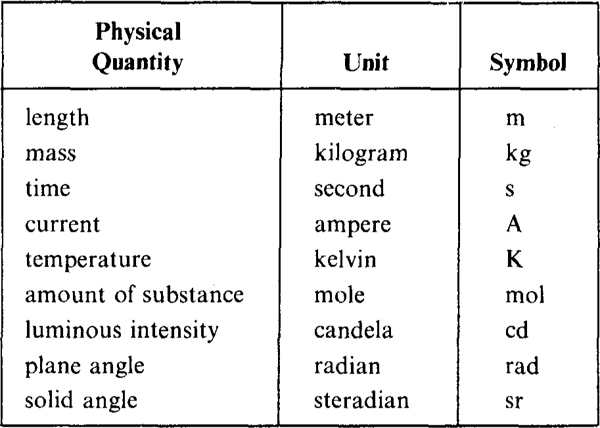
There is a decimal relation, indicated by prefixes, among multiples and submultiples of each base unit. An SI prefix is a term attached to the beginning of an SI unit name to form either a decimal multiple or submultiple. For example, since kilo is the prefix for one thousand, a kilometer equals 1000 m. And because micro is the SI prefix for one-millionth, one microsecond equals 0.000 001 s.



